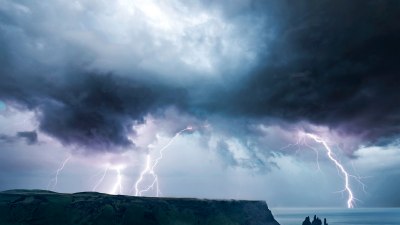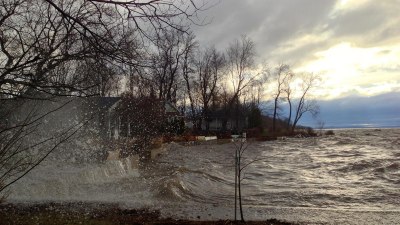What Happens Inside a Thundercloud Before a Strike
Discover the fascinating processes inside thunderclouds that lead to a lightning strike.

Thunderstorms have fascinated humankind for centuries, not only because of their awe-inspiring beauty but also due to the incredible forces of nature they represent. Among the most dramatic events associated with thunderstorms are lightning strikes, which can illuminate the sky, spark wildfires, or even cause fatalities. To truly understand the phenomenon of lightning, we must delve deep into what happens inside a thundercloud.
A thundercloud, scientifically known as a cumulonimbus cloud, is a complex system of organized moisture, temperature gradients, and electrical charges. They can rise to great heights, often reaching 40,000 feet or more into the atmosphere. Inside this towering mass of vapor, a variety of processes are taking place, which will ultimately lead to the discharge of electricity in the form of lightning.
Formation of Thunderclouds
The formation of a thundercloud begins with warm, moist air rising from the Earth’s surface. As this air ascends, it cools at higher altitudes. When the air cools to its dew point, condensation occurs, forming water droplets. This process is known as convective lifting and is the first crucial step in creating a thundercloud. As the cloud grows and condenses, it releases latent heat, which further accelerates the upward motion of air.
The presence of strong updrafts within the cloud is essential for the continued growth of the thundercloud. Updrafts carry warm, moist air into the higher regions of the atmosphere, causing the cloud to expand and develop vertically. It is this vertical growth that produces the towering structure characteristic of cumulonimbus clouds. A mature thundercloud can be immense, with a significant portion of its height extending above the freezing level, where ice crystals may begin to form.
Charge Separation in Thunderclouds
One of the most critical processes that occur inside a thundercloud is charge separation. As water droplets and ice crystals collide with each other within the cloud, they transfer electrical charges. Smaller ice particles usually acquire a positive charge, while larger hailstones tend to become negatively charged. This process is known as the collision-coalescence mechanism and plays a vital role in how charge is separated within the cloud.
The updrafts within the cloud help lift these positively charged particles to the upper regions, while the negatively charged particles tend to settle lower. This distribution leads to a strong electric field developing between the top and bottom of the cloud. The polarization of electrical charge creates a significant voltage difference that is gradually built up as the storm develops.
The Development of Lightning
As the electric field strength increases, it can eventually reach a point where it becomes strong enough to overcome the insulating properties of air. When this occurs, a lightning strike is initiated. The process begins with the formation of a stepped leader, which is a series of negative electrical discharges that travel toward the ground. This leader follows a jagged path as it descends, creating ionized channels in the air.
Once the stepped leader nears the ground, it creates a strong electric field that ionizes the air, allowing a positive charge to rise from the Earth in the form of a return stroke. This return stroke moves quickly back up to the cloud, resulting in the brilliant flash of light that we associate with lightning. In fact, around 90% of the energy released during a lightning strike is in this return stroke.
The Types of Lightning
There are several different types of lightning, each with unique characteristics. The most common type is the intra-cloud lightning, which occurs within a single thundercloud and is characterized by flashes that remain confined to the cloud. Another type is cloud-to-ground lightning, which is the one most often associated with thunderstorms and can strike the Earth's surface.
There are also variations such as cloud-to-cloud lightning, and ground-to-cloud lightning, which is less common but still occurs. Each of these types can have profound impacts on the environment, from igniting wildfires to enhancing nutrient cycling in ecosystems.
The Role of Thunder
Associated with lightning is the phenomenon of thunder. Thunder is created by the rapid expansion and contraction of air surrounding a lightning bolt. The air heats up to an incredible degree during the strike, often reaching temperatures around 50,000 degrees Fahrenheit in a fraction of a second. This rapid heating leads to a shockwave that manifests as the sound of thunder.
The distance of a lightning strike can be roughly estimated by counting the seconds between the flash and the sound of thunder that follows. Sound travels approximately 1,100 feet per second, meaning every five seconds between the flash and the boom represents about a mile.
Scientific and Practical Applications
Understanding the processes within thunderclouds has vital implications for meteorology, aviation safety, and climate science. By better comprehending how thunderclouds develop and where lightning occurs, scientists can improve weather forecasting models. This knowledge can lead to earlier warnings for thunderstorms, helping save lives and property.
Additionally, understanding lightning’s atmospheric and ecological impacts can guide land management practices and inform infrastructure development, particularly in lightning-prone regions. Researchers are continually examining the electrical properties of thunderclouds to improve lightning detection methods and mitigation strategies for both individuals and communities.
In conclusion, the processes occurring within a thundercloud before a lightning strike represent a fascinating interplay of atmospheric dynamics, electrical charge separations, and physical interactions among water and ice particles. Studying these processes not only intrigues meteorologists but also enhances our understanding of weather and climate in an ever-changing world. As we expand our knowledge, we also develop better methods to predict and respond to the powerful forces of nature represented by thunderclouds and lightning strikes.











